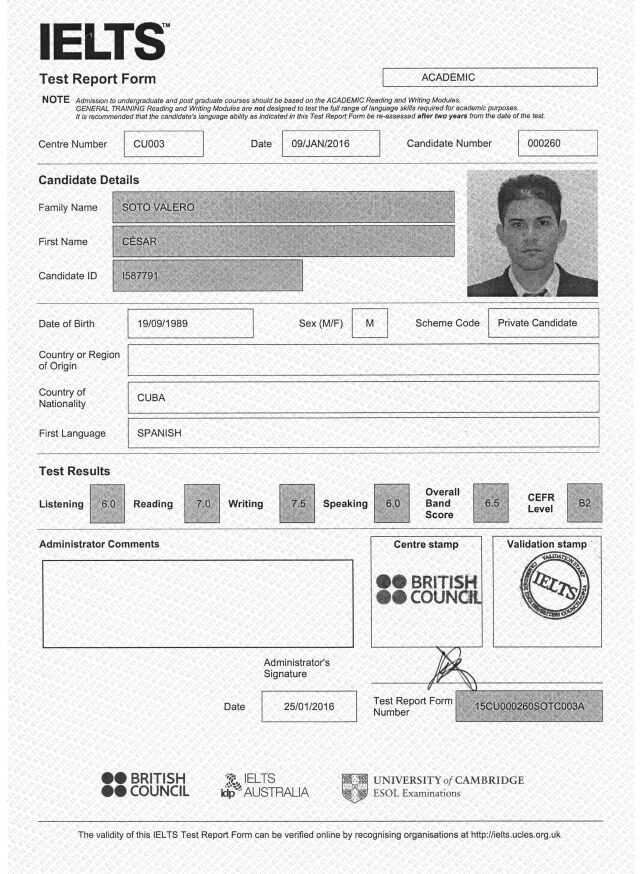The International English Language Testing System (IELTS) is one of the major English language tests for higher education and immigration in the world. It is jointly managed by the British Council, IELTS Australia, and Cambridge English Language Assessment. IELTS is accepted by most Australian, British, Canadian, and New Zealand academic institutions, by over 3,000 educational institutions in the United States, and by many professional organizations across the world.
There are two versions of the test, IELTS Academic and IELTS General Training. The first is intended for those who want to enroll in universities and other institutions for higher education, while the latter is for test-takers who want to work, study at a secondary school, or migrate to an English-speaking country. In this blog post, I will refer to the Academic version of the test.
The Test
First of all, there is no official pass or fail for the test. IELTS is scored on a nine-band scale, with each band corresponding to a specified competence in English. Band scores are used for each language subskill (Listening, Reading, Writing, and Speaking). The Band Scale ranges from 0 (“Did not attempt the test”) to 9 (“Expert User”). The IELTS minimum scores required by academic institutions and by courses vary. As a general rule, the ranked universities in the world tend to require a higher IELTS band (typically higher or equal to 6.5). Once you complete the test, your IELTS results will be available 13 days afterward, and you will receive a “test report form” like this one:

In my opinion, it is practically impossible to achieve an overall band score of 9 (the maximum) in IELTS. The test is designed to be this way. The reason? In a four-letter single word: time.
Time will be your worst enemy if you are interested in taking the IELTS. The test is divided into four sections in this order:
| Order | Test | Time |
|---|---|---|
| 1 | Listening | 30 minutes + 10 minutes’ transfer time |
| 2 | Reading | 60 minutes |
| 3 | Writing | 60 minutes |
| 4 | Speaking | 12–15 minutes |
The best advice I can give you to do well in the IELTS is to understand very well how the test works and to practice a lot. By “understand” I mean mastering all the details of the test’s structure. Practicing for IELTS is not about doing one or two parts of the tests separately but completing dozens of full tests just like the real one. Take into account that you should be prepared not for a regular English exam but for a very particular type of test that will force you to put your mind and skills to their limits.
In the following, I will divide each section of the test into parts and give suggestions and personal remarks about what is required to be completed in each of them.
Listening
The Listening Test takes between 30 minutes. You have 20 minutes to listen to a recording and 10 minutes to transfer your answers to the Listening Answer Sheet. The sheet has 4 sections, with 40 questions in total. You need to answer all the questions as you listen to the recording. The recording is not paused at any time, and you hear it only once. The questions get more difficult as you progress through the test.
The only way to improve your Listening ability is to train your ears to separate and understand the words you hear in the flow of a sentence. There is a big difference between seeing a word printed on paper while reading and hearing it. If you saw a word, it doesn’t mean you will recognize it when you listen to it. This is why you must listen to every word you have seen at least once.
Here is a list of tips and tricks I learned during my training for the Listening Test:
- Use a speaker (not earphones) during training.
- Practice using the official Answer Sheet.
- Write your answers while you’re hearing, and don’t forget to copy them to the Answer Sheet during the ten additional minutes.
- Listen to English speakers with different accents.
- Be able to distinguish the difference between the answers (which often are pronounced louder and more precisely) and the filler phrases.
- During the test, if for some reason you lose track, don’t panic, forget the issue, and continue to the next section.
Finally, recall that even when you feel confident, a lot of practice is still needed to achieve a high score in the real test. I did nearly 40 Listening Tests before attempting the actual test.
Reading
The Reading Test takes 1 hour, and your task is to read passages of text and answer questions according to what you have learned. It consists of 3 text passages and has 40 questions in total. Your job is to read the passages and either answer questions, label diagrams, complete sentences, or fill gaps. For every type of task, there are instructions and an example. Passages are taken from books, newspapers, magazines, and the topics are very diverse, from scuba diving to space exploration. Passages progress in difficulty, with the first being the easiest and third the hardest.
As I said before, time is your greatest enemy. In the Listening Test, you don’t need to worry about time, but the Reading Test is a different story. You need to manage it very carefully yourself. Be smart, due to the progression in level of difficulty, spend 15 minutes on the first passage, 20 minutes on the second, and 25 on the last one. In each passage, set aside 2 minutes to copy your answers to the Reading Answer Sheet.
Here is a list of tips and tricks I learned during my training for the reading test:
- Take a fast first glance at the full texts at the beginning.
- Don’t read, scan.
- Make a mind map of the entire text and its content.
- If you don’t know a particular keyword, then infer its meaning from the context.
- Just read the first sentence of the paragraph and look for the questions that this paragraph answers.
- Underline the words in the paragraph that explain its main idea.
- If any question takes you too much time (more than two minutes), then give up and move to the next one.
- Practice with a clock, and remember to transfer your answers to the Answer Sheet.
I thought that the Reading Test was my best part of the test, but unfortunately, I was wrong. I prepared myself for achieving a minimum of 8 in the real test. However, the passages were lengthy and complicated. The first was about the technical components of a water filter. The second was a narration about apes and their life in secured habitats. The last was a philosophical essay related to the types of dreams and their meanings.
Practicing for the Reading Test is useful but not as much as the other parts of the IELTS. This is because the vocabulary, in general, is very rich, and it is almost impossible to know and master all the words. The best practice is to refine the scanning strategy to get the main idea of each paragraph without reading it entirely.
Writing
Writing takes 1 hour and is divided into two subparts: 20 minutes to write a report and 40 minutes to write an essay. The report is based on a graph, a diagram, or a table you receive, and you must use not fewer than 150 words. The second task is to write an essay on a given topic, present and justify an opinion, or provide a solution to a problem, using no fewer than 250 words.
The essay is the most crucial part of the Writing Test (it counts for nearly 70% of the score). Writing the report must not take you more than 20 minutes, so there will be 40 minutes left for the essay. You will receive two Writing Answer Sheets to write on. Keep your writing neat, clean, and nice-looking. Leave a blank line between paragraphs and don’t write in the margins of the Answer Sheet. Don’t make a mess even if you have made a mistake; erase it as fast as you can.
Here is a list of general tips and tricks I learned during my training for the Writing Test:
- Be sure to fulfill the word limit.
- Use the official Answer Sheets.
- Memorize a writing structure and stick to it.
- Master the paraphrase skill.
In my opinion, the first part of the Writing Test is what demands the most study. You should be prepared for describing a broad set of different graphs (e.g., single and double line graphs, bar and pie charts, tables, process diagrams, maps, etc.). There is no other way than practicing and learning the grammar for each one of them. It is important to be pragmatic, writing three concise paragraphs without including additional information that doesn’t appear on the chart. Your opinion shouldn’t appear anywhere in the report.
For me, writing the essay is more comfortable than the report, and I will tell you why. You don’t have to be a writer to write a good essay. Just follow the rules, keep the right structure, use some “smart” words, and practice a little. This way, you can easily reach a level where, no matter what topic they give you, after 40 minutes, you turn out a beautiful 2-page essay and walk out of the room with a big smile on your face.
There are only three kinds of essay topics in IELTS:
- Present an argument, and you need to explore the pros and cons, reasons for and against, while you support only one side.
- Present a hidden argument. These topics usually ask “To what extent …?”, “In what way…?”, “How has something changed…?”
- Present a situation, and you need to explore reasons why it is what it is, assume what will happen in the future, and suggest solutions to problems if required.
I trained on my own structure to write each of these three kinds of essays. After a little practice, I discovered that I could write a good essay on almost all the given topics by applying the same patterns. If you want to know how I did it, I recommend you study these two sources 1 and 2.
Speaking
Speaking takes up to 15 minutes and consists of 3 parts. The first subpart of the Speaking test is an interview, where the examiner asks you questions about yourself, your work, studies, parents, brothers/sisters, pets, etc. This is an easy task to prepare for. In the second subpart of the Speaking Test, you receive a card with 3–4 questions. After one minute, during which you have to think about something to say, you should give a short speech for one to two minutes, which answers those questions. In the end, the examiner might ask you a couple of additional questions. In the third subpart of the test, you discuss it with the examiner. The topic is somehow related to the one from section two, but it is about more abstract ideas. You have to express and justify your opinions. Speaking performance is evaluated according to a set of Speaking Band Descriptors you should know.
Here is a list of general tips and tricks I learned during my training for the Speaking Test:
- Smile.
- Be confident.
- Try to be creative.
- Use a microphone to record yourself and analyze your performance.
- Use all the tenses when you speak (past, present, and future), and use them correctly.
- Prepare a phrase for clarification in case you don’t understand what the examiner is asking you.
- During the second part, don’t write on the card with the questions; use the sheet of paper instead (I made that mistake; nobody warned me).
- Watch videos on YouTube to get an idea of what the interview is about.
- Practice the second part with a clock; you need to get a notion of what it feels like to talk for two minutes in a row.
- Speak, speak, and speak!
My personal advice is that the Speaking test is strongly predictable, so once you practice during a dozen interviews, you will be able to predict the next question. I remember that I prepared myself for each of the three parts separately; it’s like a game. I was familiarized with nearly all possible common questions. It is better if you have somebody for training (my wife helped me with this part). Finally, don’t expect a friendly interviewer; they are more interested in what’s recording the microphone than in you.
Last Remarks
You should learn about all the types of tasks required in each part of the test. Make your strategy and recall that in the real test, you are going to score lower than in practice because of stress, pressure, and other factors (often one entire point lower than your average score). For instance, if you aim for a band score of seven, be sure to achieve an eight during practice.
Useful Resources
- The Official Cambridge Guide to IELTS Series 1 to 10 - Student’s Book with Answers
- Target Band 7: IELTS Academic Module - how to Maximize Your Score by Simone Braverman
- 101 Helpful Hints for IELTS Academic Module by Garry Adams and Terry Peck
- https://www.ieltsadvantage.com
- http://ielts-simon.com


